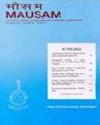孟加拉湾上层海洋分层和对流的次季节变率:河流在海洋-大气耦合模式中的作用
IF 0.7
4区 地球科学
Q4 METEOROLOGY & ATMOSPHERIC SCIENCES
引用次数: 1
摘要
孟加拉湾(BoB)从雨水和河流中接收了大量淡水,由于淡水的清新作用,导致了大规模的上层海洋分层。从理论上讲,这种盐度分层通过影响海洋混合层和阻挡层,在季节内时间尺度上影响海表温度(SST)和对流。本文旨在通过现场海洋观测和耦合模式实验,量化盐度分层对海温和对流亚季节变化的影响。研究表明,季风季节内振荡(MISOs)在海温和降雨方面表现出不同程度的季节内变化,这是基于海底条件的。海温最大的季节内变率并不会导致西北海温最大的对流变率。相反,与MISOs相关的海温和降雨的中等变率与深层混合层和厚屏障层条件共同发生。在一个耦合的海洋-大气模式中,河流淡水通量的真实表示导致季节内海温和降雨变率的改善。西北湾的厚屏障层减弱了混合层的夹带冷却,高混合层热含量为季风低压系统(LPS)的形成提供了有利的海洋条件,从而影响了印度的降雨。本研究对利用耦合模型进行运行预测具有重要意义。本文章由计算机程序翻译,如有差异,请以英文原文为准。
Bay of Bengal upper-ocean stratification and the sub-seasonal variability in convection: Role of rivers in a coupled ocean-atmosphere model
The Bay of Bengal (BoB) receives a large amount of freshwater from rains and rivers, resulting in large upper-ocean stratification due to the freshening effect. This salinity stratification has been theorized to impact sea-surface temperature (SST) and convection on intra-seasonal time scales by affecting the ocean mixed layer and the barrier layer. This article aims to quantify the impact of salinity stratification on the sub-seasonal variability in SST and convection by using in-situ ocean observations and coupled model experiments. It is shown that monsoon intra-seasonal oscillations (MISOs) exhibit varied levels of intra-seasonal variability in SST and rainfall based on the underlying ocean conditions. The largest intra-seasonal variability in SST does not cause the largest convection variability in the north-western BoB. Instead, moderate variability in SST and rainfall associated with MISOs co-occur with deep mixed layer and thick barrier layer conditions. Realistic representation of river freshwater fluxes in a coupled ocean-atmosphere model leads to improved intra-seasonal SST and rainfall variability. Thick barrier layers in the north-western Bay attenuates the entrainment cooling of the mixed layer, and the high mixed layer heat content provides conducive oceanic conditions for the genesis of monsoon low-pressure systems (LPS), thereby affecting rainfall over India. This study has important implications for operation forecasting using coupled models.
求助全文
通过发布文献求助,成功后即可免费获取论文全文。
去求助
来源期刊

MAUSAM
地学-气象与大气科学
CiteScore
1.20
自引率
0.00%
发文量
1298
审稿时长
6-12 weeks
期刊介绍:
MAUSAM (Formerly Indian Journal of Meteorology, Hydrology & Geophysics), established in January 1950, is the quarterly research
journal brought out by the India Meteorological Department (IMD). MAUSAM is a medium for publication of original scientific
research work. MAUSAM is a premier scientific research journal published in this part of the world in the fields of Meteorology,
Hydrology & Geophysics. The four issues appear in January, April, July & October.
 求助内容:
求助内容: 应助结果提醒方式:
应助结果提醒方式:


